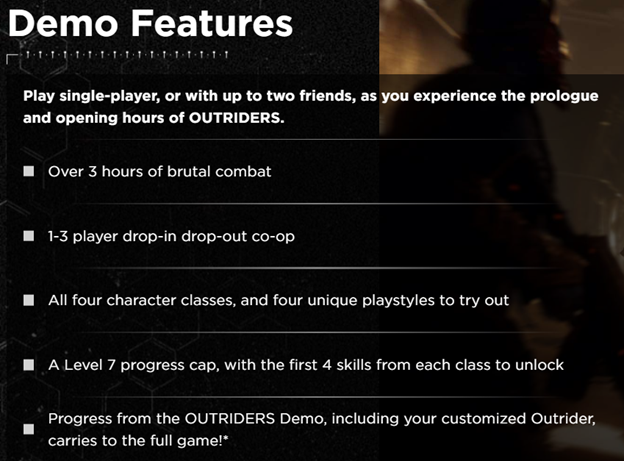How Outriders' Marketing Led to a Successful New IP
The gaming industry is full of misleading marketing that often leads to disappointment, but Outriders went back to basics and it’s working

The modern gaming industry is marked by elaborate and exaggerated marketing, oftentimes leading to a final product that fails to live up to the image presented to consumers over the years and months ahead of release and the hype that’s been brewing. Some have pointed out how the gaming industry is inherently flawed in this regard, and I’d often agree with this sentiment. But Outriders is a showcase for how transparency and focused marketing can lead to success, even for a new IP in a genre that has bred scepticism in many gamers over the past few years.

For those who haven’t heard of Outriders before, it’s a new IP from the development team at People Can Fly, previously known for the unique first-person shooter, Bulletstorm. It’s a refreshing take on the looter-shooter genre and has been garnering quite a bit of positive attention online following the demo and recent release.
The looter genre, and live service games in general, have become synonymous with a type of misleading marketing that has promised greatness, but ultimately fails to reach it. Despite being one of my favourite games, Destiny is a culprit of this, although Bungie has significantly improved the game since its launch. Before the launch of Destiny in 2014, Bungie showcased several segments of ‘gameplay’ to convey to the consumer what the final product would be. However, once players finally got their hands on the game, they quickly realised it wasn’t all it was said to be.
Whole areas were inaccessible or no longer existed, characters had been removed or reworked, and there were big structural changes during development that failed to be accurately conveyed to the public. And Destiny is only the tip of the iceberg, with more recent examples including EA’s Anthem and Square Enix’s Marvel’s Avengers. Outriders is starkly different and adamant in its focus on not following in the footsteps of those games.
Currently, the only platform where we have access to player counts is on Steam, but by that measure, it’s certainly been a hit. Despite a few serious issues in the early days, mainly server problems, Outriders grabbed over 109,000 peak players on Steam during launch day. This is more than triple the count of another Square Enix looter, Marvel’s Avengers.

Since then, it has now surpassed its own record for peak player count and put itself ahead of both Borderlands 2 and 3 on Steam. Clearly, the developers have done something right to be able to land on such a strong footing. Success is difficult for a brand-new IP in a notoriously difficult genre, and this is where People Can Fly’s transparency before release becomes apparent.
Leading up to release, the studio was engaging with the community and providing extensive information about the game, being open about exactly what Outriders would be, and exactly what it would not be. Right from the outset, they proclaimed that Outriders would not be a ‘game as a service’, promising a 100% complete game on release, clocking in at around 30 hours for the average completion. Lead narrative designer on Outriders, Szymon Barchan, told VG247 at a preview event “We’re launching with a full game that you can enjoy with everything there. That was the plan four years ago, and those are decisions and directions we’re sticking to.”
In fact, Outriders was marketed as an anti-live service game in many regards. This news came as a relief to many as it assured the community that the game would be complete right away, unlike most live service titles which required, and arguably still do require, additional content to justify the price tag. Outriders was promised to be complete, and now that it has been released it certainly feels as though the developers have fulfilled their vision for the game. It’s a refreshing shift from the season passes, microtransactions, and years of story and grind that typically plague the genre, and marketing latched onto this point as it was precisely what many players wanted.

Even before the launch of the game, the developers were showcasing end-game builds and several legendary gear pieces that players would be able to acquire when they got their hands on it. They went in-depth with the systems at play and the content included, and at no point did they appear vague or misleading. As a result, consumers could set accurate expectations for the game as they understood how the game functioned, particularly the ever-elusive ‘end-game’ that is a staple of the genre.
A small detail, but one that stood out to me personally, was the developers’ clear passion and hope for the game. Despite their commitment to dissociate with the trend of ‘live service’, they showcase a true passion for the game they’ve created when they claim that they’d like to continue supporting the game after release. Bartosz Kmita, game director on Outriders, was adamant that they will not “abandon the game immediately after launch”.
The decisive quote for me, however, was: “Even if the game isn’t super successful, we still have plans to make some adjustments to the balance and some other things. But if the game is more successful and people like it, we’re more than happy to create more adventures — it’s up to how players react to the game and how they feel overall about the game.” This approach to post-launch content is one that I’d like to see more studios take. I’d rather get a full game at launch, with the hope of additional expansions down the line if it’s popular than to receive half a game at launch only to drip feed content throughout the following months and years, packaged with microtransactions. It’s a very honest approach that has resonated with many.
Perhaps the most significant aspect of People Can Fly’s approach was to make a demo. Yes, you read that right — a demo. Game demos have basically gone extinct in the modern games industry so it was a huge surprise to hear that there would be a demo for Outriders. After trying it out myself I was thoroughly impressed. I’d recommend downloading the demo for yourself, it might surprise you too.

The demo showcases the opening hours of the game in full and all four classes, with players able to reach a level cap of 7. Releasing a demo was a huge move by the studio as it would give players their first hands-on with the game, well before the release of the full version. Yet again, this was an important part of their transparency as any flaws with the game would immediately be made apparent, so they must’ve been confident with their product. This certainly paid off for them too, as many, including myself, were not initially all that interested in the game. Once I got my hands on the demo, however, that completely changed.
Finally, just over two weeks before launch it was announced that Outriders would be coming to Xbox Game Pass (sadly just Xbox and not PC as of yet) on day one, meaning anyone with a Game Pass subscription would be able to jump right in. This is undoubtedly a huge boon, particularly for a new IP as it gave Outriders a strong footing at launch, which it otherwise might have lacked.
All these points had people spreading the positive word on Outriders, even before launch, and contributed to such a successful release. People Can Fly and Square Enix’s transparency and openness before launch reveal the faults of the industry today, with many titles having misleading marketing, resulting in failed launches and disappointed gamers. We can only hope that People Can Fly and Square Enix have set a precedent for other studios to follow suit.
